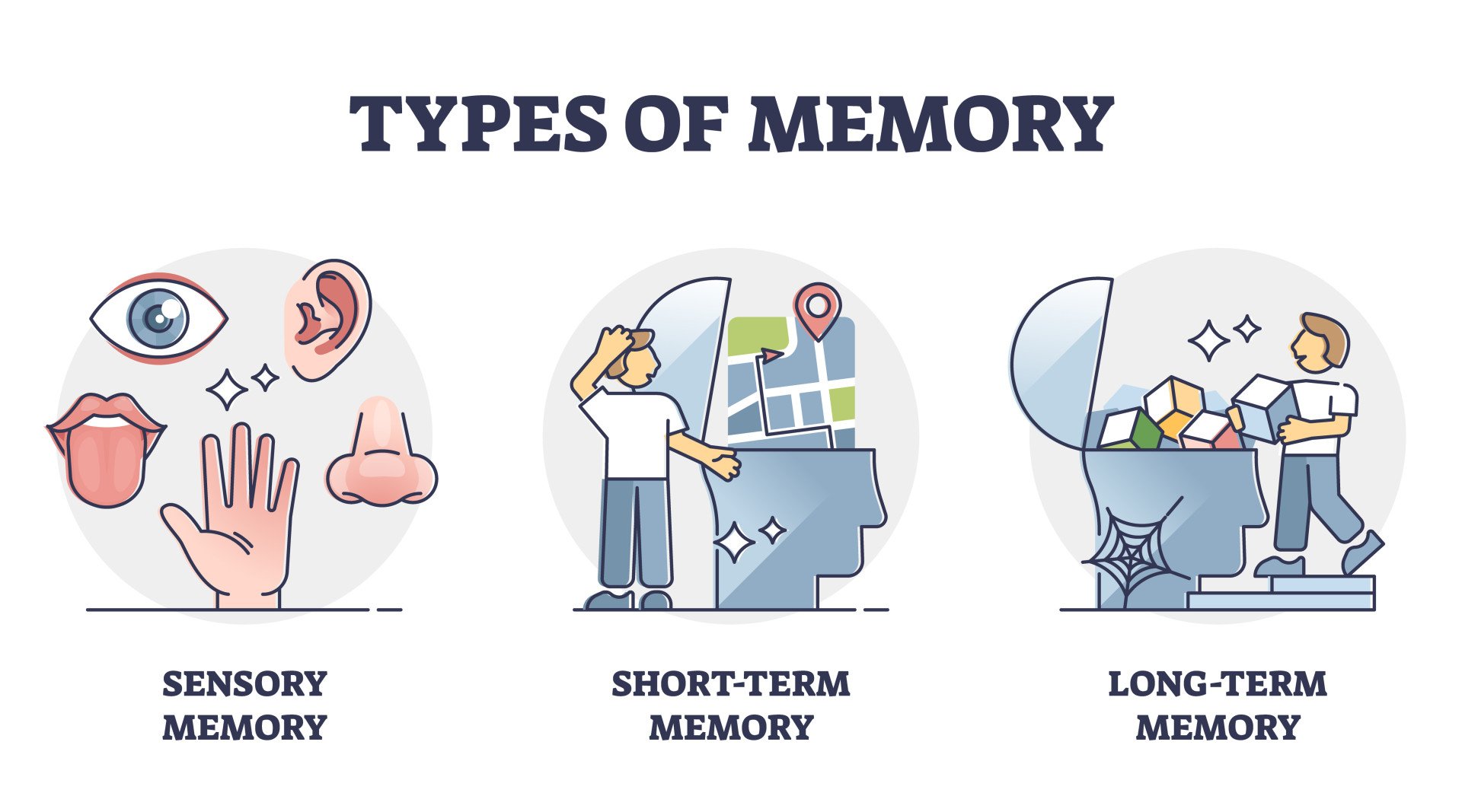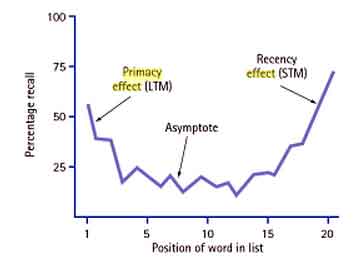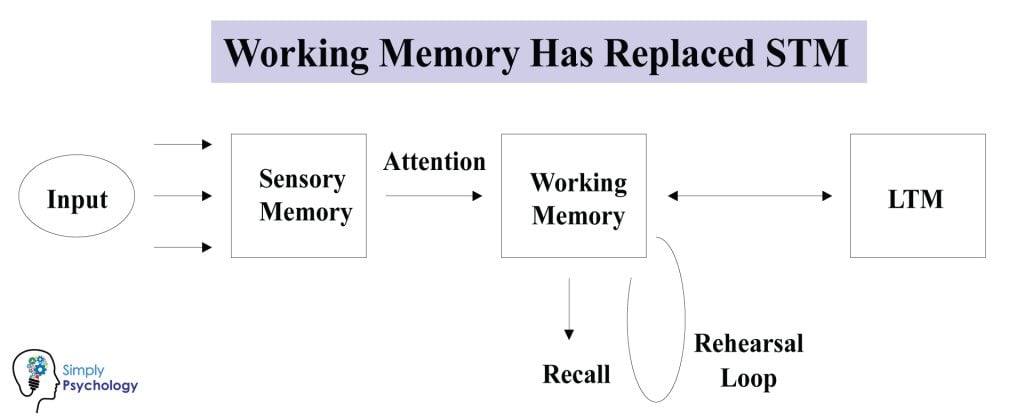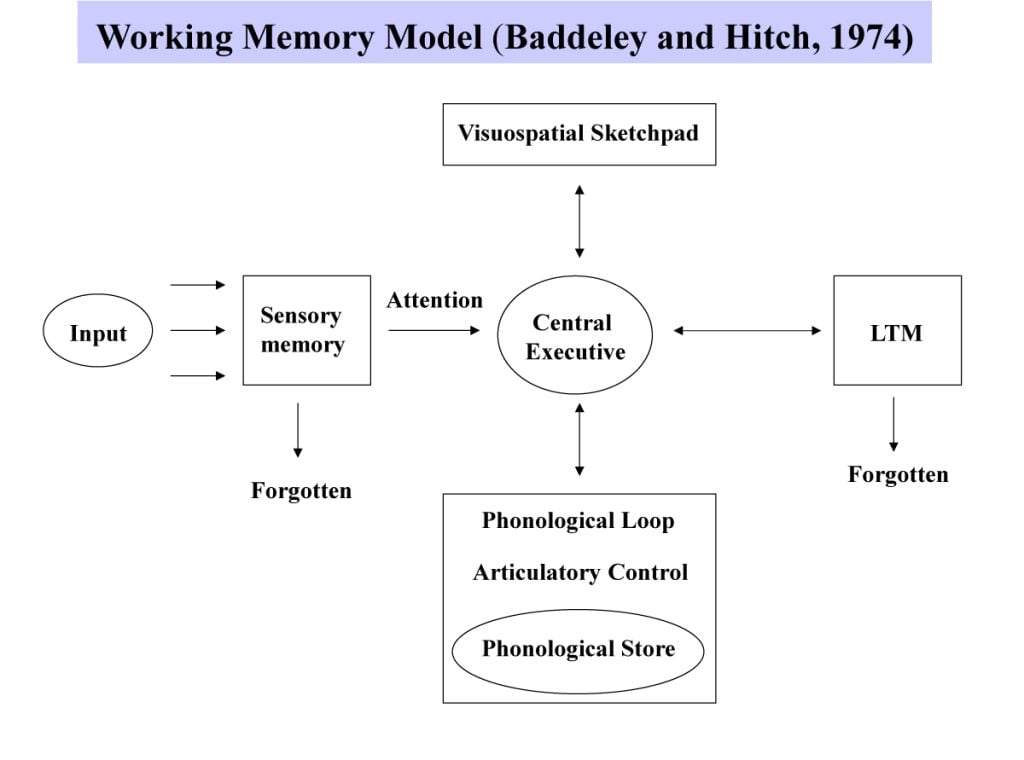The multi-store model of memory (MSM), proposed by Atkinson and Shiffrin, describes memory as comprising three distinct stores: sensory memory, short-term memory (STM), and long-term memory (LTM).
Information moves through these stores sequentially in a linear process, via attention, rehearsal, and retrieval.

Initially, sensory information detected by our senses enters sensory memory, briefly holding impressions.
If attention is paid to this information, it moves into short-term memory.
Through rehearsal especially elaborative rehearsal, which gives information meaning it can then transfer into long-term memory for prolonged storage.
Each memory store differs in three key ways: encoding, capacity, and duration.
- Encoding: This is the process of converting information into memory traces (code) for storage and can be visual (images), acoustic (sounds), or semantic (meaning).
- Capacity: This refers to how much information can be held in the memory store.
- Duration: This is the amount of time the information is held in the memory store.
The MSM can be likened to how a computer processes data, with clear stages: input (information entering), processing (encoding and storage), and output (retrieval).

Sensory Memory
Sensory memory (or sensory register) is like a very quick snapshot that your brain takes of everything happening around you.
It captures sights, sounds, smells, tastes, and touches – but only for an instant, typically lasting less than a second.
For example, if you glance at a car and then immediately close your eyes, you’ll still briefly see the image of that car in your mind for about half a second before it fades away.
Sensory memory helps you experience your environment smoothly and continuously, even though it holds each sensation only momentarily.
Key Features
- Duration: between 0.25 milliseconds and 2 seconds.
- Capacity: All sensory experience (v. larger capacity).
- Encoding: Sense specific (e.g. different stores for each sense).
How It Works
Think about how you briefly see the trail of a sparkler in the dark or how someone’s words echo in your ears just after they’ve spoken.
These fleeting impressions happen in your sensory memory.
Because it’s so brief, most of this information disappears unless you pay attention to it, at which point it moves into your short-term memory.
The sensory stores are constantly receiving information but most of this receives no attention and remains in the sensory register for a very brief period.
Atkinson and Shiffrin (1968) explained that sensory memory stores information exactly how it’s received from your senses.
For example, images you see are stored visually (called iconic memory), and sounds you hear are stored as sounds (called echoic memory)
The sensory memory store has a large capacity but a very brief duration, it can encode information from any of the senses and most of the information is lost through decay.
Attention is the first step in remembering something, if a person’s attention is focused on one of the sensory stores then the data is transferred to STM.
Short Term Memory
Short-term memory is like your brain’s temporary notepad, holding information for a brief period – usually about 0 to 18 seconds.
It’s what you use when remembering someone’s name you’ve just heard, a phone number you’re about to dial, or directions someone gives you.
Think of it as your mental workspace, where information stays briefly unless you actively repeat it or give it meaning.
However, short-term memory has limited space, typically holding around 5 to 9 items at once. If you don’t actively keep thinking about or rehearsing this information, it fades quickly.
- Duration: Information is held in short-term memory for a brief period, typically around 15 to 30 seconds, if it is not actively rehearsed.
- Capacity: 7 +/- 2 items
- Encoding: mainly auditory or phonemic coding (meaning it’s coded based on sound).
Maintenance rehearsal
Maintenance rehearsal is the process of verbally or mentally repeating information, which allows the duration of short-term memory to be extended beyond 30 seconds.
For example, repeating a phone number until you dial it is maintenance rehearsal. However, this method usually doesn’t involve giving meaning to the information or linking it to other memories.
This type of rehearsal usually involves repeating information without thinking about its
meaning or connecting it to other information.
Continual rehearsal “regenerates” or “renews” the information in the memory trace, thus
making it a stronger memory.
Information in short-term memory is lost because new information pushes it out (displacement) or it naturally fades over time (decay).
Long Term Memory
Long-term memory is like your brain’s personal library, storing everything you’ve learned and experienced throughout your life.
It holds memories from days, months, or even years ago – like the name of your childhood friend, how to ride a bike, or details from your favorite movie.
Unlike short-term memory, long-term memory has almost unlimited space and can store information indefinitely. However, for memories to last, they usually need to be meaningful or frequently used.
Think of long-term memory as a filing system: the better organized the files (or memories), the easier it is to retrieve them later.
- Duration: Unlimited (information in the LTM can potentially last a whole lifetime).
- Capacity: Unlimited
- Encoding: Mainly Semantic (based on what it means), but can be visual and auditory.
Elaborative rehearsal
If the information is given meaning (elaborative rehearsal) it is transferred from STM to LTM.
Elaborative rehearsal involves linking new information in a meaningful way with information already stored in long-term memory.
Instead of just repeating something over and over, you connect new information to something you already know or create associations that make it personally relevant.
Simply put, elaborative rehearsal is all about giving new information meaning and context, which makes it stick better in your memory.
For example, if you’re trying to remember someone’s name, you might connect it to someone else you know with the same name, imagine a vivid picture involving their name, or think about what their name means.
Elaborative rehearsal is more effective than maintenance rehearsal for remembering new information as it helps to ensure that information is encoded well. It is a deeper level of information-processing.
These meaningful connections help strengthen memories, making them easier to recall later and helping transfer information into your long-term memory.
Key Studies
These experiments clearly show the key aspects (duration, encoding, capacity) that define the multi-store model of memory and provide solid evidence for its distinct, separate memory stores.
1. Glanzer and Cunitz (1966) – Serial Position Effect
-
Aim: To examine if the position of words in a list affects how well they’re remembered.
-
Method: Participants were shown lists of words and then immediately asked to recall them. In some conditions, participants waited 30 seconds before recalling to prevent rehearsal.
-
Results: People remembered words at the beginning (primacy effect) and the end (recency effect) of the list better than words in the middle. When rehearsal was prevented, the recency effect disappeared, but the primacy effect remained.
-
Conclusion: This supports the multi-store model by suggesting the first words are stored in long-term memory (due to rehearsal), and the last words stay briefly in short-term memory.

2. Peterson and Peterson (1959) – Duration of Short-Term Memory
-
Aim: To measure how long short-term memory holds information without rehearsal.
-
Method: Participants briefly saw trigrams (sets of three letters like “BRT”). Immediately afterward, they counted backward by threes to prevent rehearsal. After intervals of 3, 6, 9, 12, 15, or 18 seconds, they had to recall the trigram.
-
Results: After just 18 seconds, recall accuracy dropped dramatically to about 10%.
-
Conclusion: Short-term memory has a limited duration of roughly 18–30 seconds without rehearsal, supporting the multi-store model’s idea of STM as temporary storage.
3. Baddeley (1966) – Encoding in Short-Term and Long-Term Memory
-
Aim: To investigate how information is encoded in short-term and long-term memory.
-
Method: Participants were asked to memorize word lists that either sounded similar (e.g., cat, cab, can) or had similar meanings (e.g., big, huge, large). They then had to recall words either immediately (testing STM) or after a delay (testing LTM).
-
Results: Immediate recall (STM) was worse for acoustically similar words, suggesting short-term memory relies heavily on sound-based encoding. After a delay (LTM), semantic similarity (meaning) caused more confusion.
-
Conclusion: This supports MSM by showing short-term memory is primarily acoustic, whereas long-term memory encodes mainly based on meaning.
4. Miller (1956) – Capacity of Short-Term Memory
-
Aim: To explore how many items short-term memory can hold.
-
Method: Reviewed various studies where participants remembered lists of letters, numbers, or words.
-
Results: Most participants could accurately remember about 7 items, give or take 2 (known as Miller’s magic number, 7±2).
-
Conclusion: Demonstrates short-term memory has limited storage capacity, reinforcing the MSM’s claim that STM can hold only a small amount of information at once.
5. Jacobs (1887) – Digit Span Test
-
Aim: To test the capacity of short-term memory for numbers and letters.
-
Method: Participants repeated sequences of digits or letters in the correct order; sequences increased in length until mistakes occurred.
-
Results: Participants recalled on average 9 digits and about 7 letters.
-
Conclusion: Demonstrates the limited capacity of short-term memory, supporting MSM’s idea of STM’s restricted storage.
6. Bahrick et al. (1975) – Duration of Long-Term Memory
-
Aim: To investigate how long memories last in real-life settings.
-
Method: Participants (aged 17 to 74) identified former classmates from yearbook photos and recalled their names years after leaving school.
-
Results: Recognition remained strong (around 90%) even after 15 years, and substantial (70–80%) even after nearly 50 years.
-
Conclusion: Indicates long-term memory has a very large capacity and can retain information over decades, supporting MSM’s distinction of LTM as long-lasting.
7. Conrad (1964) – Acoustic Encoding in STM
-
Aim: To examine how short-term memory encodes information.
-
Method: Participants saw lists of letters briefly and recalled them immediately. Letters sounded either similar (e.g., B, C, D) or different (e.g., F, H, Q).
-
Results: Recall mistakes often involved mixing up letters that sounded alike, rather than those that looked alike.
-
Conclusion: Short-term memory primarily encodes information acoustically (by sound), reinforcing MSM’s explanation of STM encoding.
Critical Evaluation
Strengths
1. Clear Structure and Influential
One strength is that MSM provides a clear, easy-to-understand structure of memory.
This clear structure allows researchers to build upon and test its validity.
Its influence has led to extensive research on memory, increasing our understanding of the processes involved.
2. Evidence from Research
Numerous studies support MSM by demonstrating clear distinctions between Short-Term Memory (STM) and Long-Term Memory (LTM). For instance:
-
Glanzer & Cunitz demonstrated the primacy and recency effects, showing differences in how STM and LTM function.
-
Case study of HM: After his hippocampus was removed, HM was unable to form new long-term memories (e.g. death of mother and father) while his short-term memory remained intact, supporting the idea that STM and LTM are separate stores.
Weaknesses
1. Oversimplification of Short-Term Memory
The MSM views STM and LTM as singular, uniform stores, but research indicates that memory is more complex and involves multiple components.
Working memory (Baddeley & Hitch, 1974) showed that short term memory is more than just one simple unitary store and comprises different components.
-
Central Executive: Directs attention and allocates resources.
-
Phonological Loop: Manages verbal and auditory information.
-
Visuospatial Sketchpad: Handles visual and spatial data. This model demonstrates that STM involves active processing rather than passive storage alone.

Baddeley and Hitch (1974) argue that the picture of short-term memory (STM) provided by the Multi-Store Model is far too simple.

Fig 2 . The Working Memory Model Components (Baddeley and Hitch, 1974)
The model proposes that every component of working memory has a limited capacity, and also that the components are relatively independent of each other.
In the case of long-term memory, it is unlikely that different kinds of knowledge, such as remembering how to play a computer game, the rules of subtraction and remembering what we did yesterday are all stored within a single, long-term memory store.
Indeed different types of long-term memory have been identified, namely episodic (memories of events), procedural (knowledge of how to do things) and semantic (general knowledge).
2. Neglects Different Types of LTM
MSM treats LTM as a single, uniform store, but research indicates multiple distinct long-term memory systems:
-
Episodic memory: Personal experiences and events (e.g., your birthday party).
-
Procedural memory: Skills and actions (e.g., riding a bike).
-
Semantic memory: General knowledge and facts (e.g., capital cities). Each type of memory is stored and retrieved differently, something MSM does not clearly explain.
3. Overemphasis on Rehearsal
Rehearsal is considered a too simple explanation to account for the transfer of information from STM to LTM.
For instance, the multi-store model ignores factors such as motivation, mood and strategy (e.g. mnemonics) which underpin learning.
Also, rehearsal is not essential to transfer information into LTM.
For example, why are we able to recall information which we did not rehearse (e.g. swimming) yet unable to recall information which we have rehearsed (e.g. reading your notes while revising).
Therefore, the role of rehearsal as a means of transferring from STM to LTM is much less important than Atkinson and Shiffrin (1968) claimed in their model.
4 . Structure-Focused, Ignoring Detailed Processes
MSM emphasizes memory structures but overlooks detailed cognitive processes involved in memory encoding and retrieval.
The model primarily highlights attention and maintenance rehearsal, but fails to adequately explain the cognitive depth required for long-term retention:
Later models, such as the levels of processing model proposed by Craik & Lockhart (1972), emphasize that the depth and meaningfulness of processing (elaborative rehearsal) significantly affect memory retention.
Elaborative rehearsal involves analyzing information more deeply by associating new information with existing knowledge, creating vivid imagery, and generating meaningful associations, leading to more durable and easily retrievable memories compared to simple repetition.
References
Atkinson, R. C., & Shiffrin, R. M. (1968). Chapter: Human memory: A proposed system and its control processes. In Spence, K. W., & Spence, J. T. The psychology of learning and motivation (Volume 2). New York: Academic Press. pp. 89–195.
Baddeley, A .D., & Hitch, G. (1974). Working memory. In G.H. Bower (Ed.), The psychology of learning and motivation: Advances in research and theory (Vol. 8, pp. 47–89). New York: Academic Press.
Craik, F. I. M., & Lockhart, R. S. (1972). Levels of processing: A framework for memory research. Journal of Verbal Learning and Verbal behavior, 11, 671-684.
Raaijmakers, J.G.W. & Shiffrin, R.M. (2003). Models versus descriptions: Real differences and langiage differences. behavioral and Brain Sciences, 26, 753.
Shallice, T., & Warrington, E. K. (1977). Auditory-verbal short-term memory impairment and conduction aphasia. Brain and Language, 4(4), 479-491.

